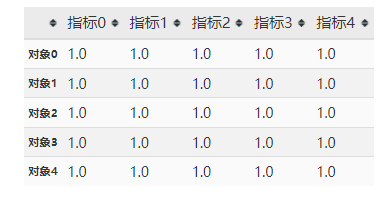一、灰色关联分析
有关灰色关联的数学解释 向博客大佬 进行学习
值得一说的是 灰色关联矩阵 并没有像协方差矩阵和皮尔逊系数矩阵具有对称性
1.导入依赖包
import pandas as pd
import matplotlib.pyplot as plt
import numpy as np
from sklearn.preprocessing import MinMaxScaler
2.数据存放格式如下
# 表格形如以下形式,数据写入Excel即可调用RA函数
pd.DataFrame(np.ones(shape=(5, 5)),
columns=['指标{}'.format(i) for i in range(5)],
index=['对象{}'.format(i) for i in range(5)])

3.归一化数据
4.编写程序
ζ
i
(
k
)
=
min
s
min
t
∣
x
0
(
t
)
−
x
s
(
t
)
∣
+
ρ
max
s
max
t
∣
x
0
(
t
)
−
x
s
(
t
)
∣
∣
x
0
(
k
)
−
x
i
(
k
)
∣
+
ρ
max
s
max
t
∣
x
0
(
t
)
−
x
s
(
t
)
∣
{{\zeta }_{i}}(k)=\frac{\underset{s}{\mathop{\min }}\,\underset{t}{\mathop{\min }}\,\left| {{x}_{0}}(t)-{{x}_{s}}(t) \right|+\rho \underset{s}{\mathop{\max }}\,\underset{t}{\mathop{\max }}\,\left| {{x}_{0}}(t)-{{x}_{s}}(t) \right|}{\left| {{x}_{0}}(k)-{{x}_{i}}(k) \right|+\rho \underset{s}{\mathop{\max }}\,\underset{t}{\mathop{\max }}\,\left| {{x}_{0}}(t)-{{x}_{s}}(t) \right|}
ζi(k)=∣x0(k)−xi(k)∣+ρsmaxtmax∣x0(t)−xs(t)∣smintmin∣x0(t)−xs(t)∣+ρsmaxtmax∣x0(t)−xs(t)∣
def minmin(x0, x): #x0为参考数列;x为对象矩阵
a = np.abs(x - x0)
b = np.min(a, axis=1)
return b.min()
def maxmax(x0, x):
a = np.abs(x - x0)
b = np.max(a, axis=1)
return b.max()
def kesi(x0, x, amin, bmax, k, ro=0.5):
c = np.abs(x - x0)
kesi_k = (amin + ro * bmax) / (c + ro * bmax)
return kesi_k.mean(axis=1).reshape(-1)
# 关联矩阵
def RA(x1, x): #x,x均为矩阵
amin = minmin(x1[0], x)
bmax = maxmax(x1[0], x)
res = kesi(x1[0], x, amin, bmax, 1, ro=0.5)
for row in range(1, x1.shape[0]):
x0 = x1[row]
amin = minmin(x0, x)
bmax = maxmax(x0, x)
res1 = kesi(x0, x, amin, bmax, 1, ro=0.5)
res = np.vstack((res, res1))
return res
5.数据导入验证模型
x0 = np.array([[8, 9, 8, 7, 5, 2, 9], [7, 8, 7, 5, 7, 3, 8]])
x = np.array([[7, 8, 7, 5, 7, 3, 8], [9, 7, 9, 6, 6, 4, 7],
[6, 8, 8, 8, 4, 3, 6], [8, 6, 6, 9, 8, 3, 8],
[8, 9, 5, 7, 6, 4, 8], [8, 9, 8, 7, 5, 2, 9],
[7, 8, 7, 5, 7, 3, 8], [9, 7, 9, 6, 6, 4, 7],
[6, 8, 8, 8, 4, 3, 6]])
x = np.random.normal(0, 1, (6, 9))
6.计算矩阵,并打印热力图
G = RA(x, x)
import seaborn as sns
import matplotlib.pyplot as plt
plt.rcParams['font.sans-serif'] = ['SimHei'] #显示中文
plt.rcParams['axes.unicode_minus'] = False #用来正常显示负号
fig, ax = plt.subplots(1, 1) #必须这一句,不然无法show
sns.heatmap(G, cmap='Greys', annot=True)
plt.xticks(
np.arange(x.shape[0]) + 0.5,
['因子{}'.format(i) for i in range(1, x.shape[0] + 1)])
plt.yticks(
np.arange(x.shape[0]) + 0.5,
['因子{}'.format(i) for i in range(1, x.shape[0] + 1)])
plt.savefig(r'./灰色关联热力图.png', dpi=300)
plt.show()
 7、完整代码
7、完整代码
import pandas as pd
import matplotlib.pyplot as plt
import numpy as np
import seaborn as sns
from sklearn.preprocessing import MinMaxScaler
plt.rcParams['font.sans-serif'] = ['SimHei'] #显示中文
plt.rcParams['axes.unicode_minus'] = False #用来正常显示负号
def minmin(x0, x): #x0为参考数列;x为对象矩阵
a = np.abs(x - x0)
b = np.min(a, axis=1)
return b.min()
def maxmax(x0, x):
a = np.abs(x - x0)
b = np.max(a, axis=1)
return b.max()
def kesi(x0, x, amin, bmax, k, ro=0.5):
c = np.abs(x - x0)
kesi_k = (amin + ro * bmax) / (c + ro * bmax)
return kesi_k.mean(axis=1).reshape(-1)
# 关联矩阵
def RA(x1, x): #x,x均为矩阵
amin = minmin(x1[0], x)
bmax = maxmax(x1[0], x)
res = kesi(x1[0], x, amin, bmax, 1, ro=0.5)
for row in range(1, x1.shape[0]):
x0 = x1[row]
amin = minmin(x0, x)
bmax = maxmax(x0, x)
res1 = kesi(x0, x, amin, bmax, 1, ro=0.5)
res = np.vstack((res, res1))
return res
看完了,不管好不好点个赞呗
























 1万+
1万+











 被折叠的 条评论
为什么被折叠?
被折叠的 条评论
为什么被折叠?








